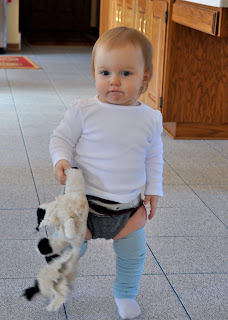A little over a year ago I read the book “In Defense of Food: An Eater’s Manifesto” by Michael Pollan. Seriously this is one of the best books I have read in terms of having an actual impact on my thinking and behavior. I read a lot. Well, before I had Miss I read a lot. Now I read a lot for someone who chases a toddler around all day 🙂 Most of the time, because I read so much, I finish a book and then purge all that I just read from my memory (I don’t do it intentionally, it just happens that way). This prevents too much crazy clutter in my brain, and also allows me to enjoy reading a book again a few years after reading it the first time, though I only do this with books I really loved.
Category: Uncategorized
Quote for the Day – One of my Favorites
Go Green Locally!
Then I heard the phrase “100-mile challenge” from my mom. I had not heard of this specific idea of challenging oneself to eat only things grown or produced within a 100-mile radius of one’s own home. I had no idea until very recently (yesterday) that there had actually been a television show called “The 100-Mile Challenge” on the Planet Green channel. But after hearing the term from my mom I started to really think about it. My husband and I discussed it. “Could we really do it?” we wondered. Not knowing about the television show or about many of the different “challenges” out there where people try to eat locally for a week or a month or some other specified time period, we were thinking of making this more of a lifestyle change. Here are a few reasons why we wanted to really try to eat locally:
- Locally grown food typically tastes better. It doesn’t have to travel for days so it can stay on the tree/vine/plant or whatever until it is riper, which means it will taste better. This seems to apply to fruit especially. I’m pretty sure bananas are the only fruit that actually improve in taste (get sweeter) after they are picked from the tree. Every other fruit may “ripen” in texture or color, but the flavor remains the same as the day it was picked, so the longer it can stay “on,” the sweeter it will be.
- I like the idea of knowing where my food comes from and how it is produced. Period.
- Buying local in general helps support the local economy, and buying local food helps support local, often smaller-scale, farmers.
- Buying local helps the environment by saving tons of gas needed to transport food halfway around the world.
There are lots of other reasons, but these were the big ones for us. So we started doing some research. I found some amazing resources on the web. Here are a few:
http://www.eatlocalchallenge.com/
http://100milediet.org/get-started/map
Yes, there is a term for the people who try to follow the movement to eat locally – Locavores. Who knew?? Anyway, I also hit the jackpot by typing in to a Google search “eat local Wisconsin.” There are tons of websites with information on farmers markets, CSAs, and all sorts of other sources for local food. So, yes, the information is out there. One thing that was slightly discouraging is that I went to the website of the show “The 100-Mile Challenge” and saw all the places where they had people participating in the challenge. Not one was in the Midwest. They were all coastal and/or southern. That gave me a brief pause, but I decided that living where we live would just make us have to be more creative, and somewhat more flexible in our efforts to eat locally.
So, here’s where we stand now. I first needed to determine our “100-mile” area. I went to the second link above to find it. I ended up adjusting it slightly to avoid having half of our eastern area in Lake Michigan, and utilized three of the four state borders to make it easier. So we have our area. Next we needed some guidelines, or “rules.” I found a great heuristic on the Eat Local Challenge website:
If not LOCALLY PRODUCED, then Organic.
If not ORGANIC, then Family farm.
If not FAMILY FARM, then Local business.
If not a LOCAL BUSINESS, then Fair Trade.
Apparently this is the Locavore Pledge. I like this way of thinking about eating locally, because it allows for some wiggle room. As I said, my husband and I wanted to make a lifestyle change, not just challenge ourselves to something really hard and potentially restricting for a month or so. We wanted to be realistic, and there are some things that we just didn’t feel we could give up, coffee and olive oil being two examples. But the above rule of thumb allows for some things outside our “100 miles” while at the same time ensuring that we still pay attention to where these things come from and how they are produced.
Bottom line: We have already started trying to eat more locally, as noted above. We will begin our true conversion to almost exclusively local foods in June. We have signed up for our CSA again, from which we get a huge box of produce from a nearby farm each week from June through October (the start of our switch will coincide with the first box). We also will get honey from the CSA. We will plant a backyard garden for items we do not get from the CSA. So far we’re planning to plant asparagus, shallots, bell peppers, raspberries, sweet potatoes, spinach and many herbs, though we may add more. We have found a local source of meat, including beef, pork, chicken (and eggs), and turkey. We will continue to get our chicken, pork, and occasionally turkey from them. We typically eat venison instead of beef, but if our supply of venison from last hunting season runs out, we will get beef from them as well. I have found some sources online for local fish, such a trout. We are still looking for walleye and hopefully some salmon from the Great Lakes. We will frequent farmers markets for any items we don’t get enough of in our CSA boxes or from our own garden. We will also seek out and visit local strawberry patches, apple orchards, bakeries for locally made breads, etc. I haven’t had a chance to delve completely into all the places around where we can get all the things we need, but the information is there and we will find it!
Miss loves plants. I’m excited to let her help in our garden this summer!
A few things we certainly cannot get locally, but will still buy include coffee, olives and olive oil, bananas, and citrus fruits, limes in particular (I love to cook with lime). I have started working on finding good sources for these items. I buy coffee that isn’t grown but is roasted in nearby Door County or I buy organic fair trade coffee. I get organic bananas and citrus fruit when they are available. Olives are a bit trickier, but I do buy organic olive oil. Though we are not giving up everything we can’t get locally, we will be conscientious of our sources and buy these things a bit more sparingly.
This plan is intended to last us through the summer and much of the fall. However, being in Wisconsin, our local food sources diminish significantly come November, particularly for produce. I am planning to can and/or freeze as much as I can this summer to last much of the winter. However, I just can’t commit to give up fresh (relatively speaking of course!) produce altogether for the long winter we have here. So we will apply our rules of thumb above to allow for some purchase of produce through the winter months as well. Primarily this will mean buying organic produce from the local grocery. Most other items should still be available locally (meats, cheese, eggs, breads, etc.). So that’s it in a really long nutshell!
If you’re thinking about trying to eat more locally, there are many things you can do. So many websites have great information, like the ones I have listed above, or can help find local sources. Some things to search include “CSA your town,” or “eat local your town or state.” Or just pay more attention when you’re in the grocery store to the labels on food. You can often find a local producer for items you had no idea were produced locally. The heuristic above is a good way to think of the process. Whether you want to try it for a week, a month, or a lifestyle change, or even just to start trying to find a few more items locally, I’ll bet you’ll find it easier than you think it will!
Amy is a stay-at-home-mom to her 13-month-old daughter and is expecting another baby in August. She occasionally works outside the home consulting as a forensic psychologist. She loves being a mom and trying to do the most healthy things possible for her family and the environment. She writes the blog Motherhood and Miscellany.
Miss’s One-Year Photos
“Miss”-cellany and More
A very happy St. Patty’s Day
Winner of the Hugga Buns OS diaper
The winner is entry #4 – Mad for following me on Twitter. Congratulations!
Just some photos
 Miss loves to talk on the phone. Rather, she loves to pretend to talk on the phone. When I put the phone up to her ear with another person really on the line, like my mom, she gets all wide-eyed and clams up! But when there’s no one on the other end, she loves to have pretend phone conversations, whether it’s with the real phone, one of her toy phones, or something that sort of resembles a phone, like the alarm clock in our guest bedroom. Don’t be alarmed (sorry, couldn’t resist!), it’s unplugged.
Miss loves to talk on the phone. Rather, she loves to pretend to talk on the phone. When I put the phone up to her ear with another person really on the line, like my mom, she gets all wide-eyed and clams up! But when there’s no one on the other end, she loves to have pretend phone conversations, whether it’s with the real phone, one of her toy phones, or something that sort of resembles a phone, like the alarm clock in our guest bedroom. Don’t be alarmed (sorry, couldn’t resist!), it’s unplugged.
Progress

































